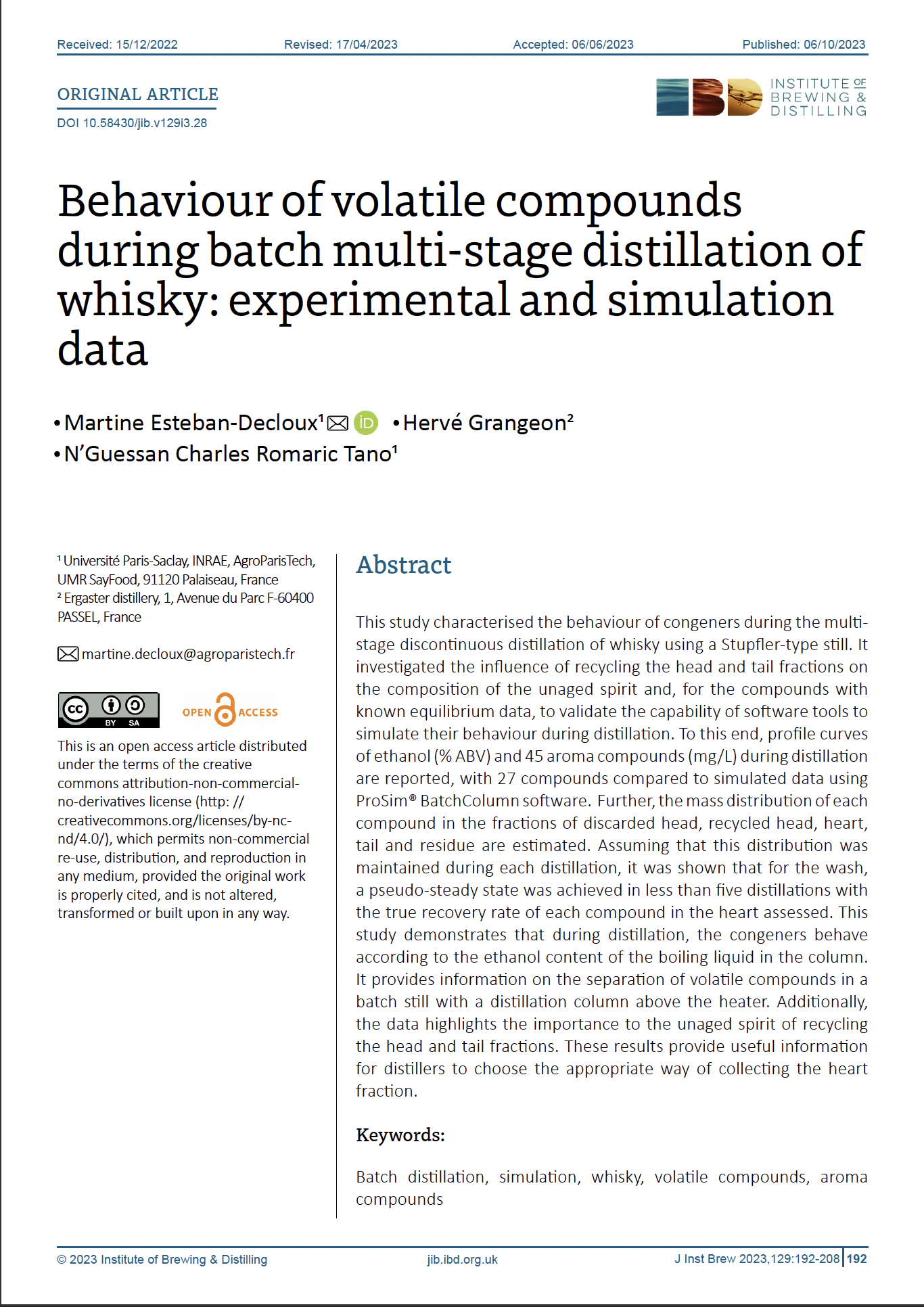Behaviour of volatile compounds during batch multi-stage distillation of whisky: experimental and simulation data
DOI:
https://doi.org/10.58430/jib.v129i3.28Keywords:
Batch distillation, simulation, whisky, volatiles, aroma compoundsAbstract
This study characterised the behaviour of congeners during the multi-stage discontinuous distillation of whisky using a Stupfler-type still. It also investigated the influence of recycling the head and tail fractions on the composition of the unaged spirit and, for the compounds with known equilibrium data, to validate the capability of software tools to simulate their behaviour during distillation. To this end, profile curves of ethanol (% ABV) and 45 aroma compounds (mg/L) during distillation are reported with 27 compounds, compared to simulated data using ProSim® BatchColumn software. Further, the mass distribution of each compound between the fractions of discarded head, recycled head, heart, tail and residue are estimated. Assuming that this distribution was maintained during each distillation, it was shown that for the wash, a pseudo-steady state was achieved in less than five distillations, and the true recovery rate of each compound in the heart was assessed. This study clearly demonstrates that during distillation, the congeners behave according to the ethanol content of the boiling liquid in the column. It provides real information on the separation of volatile compounds with a batch still with a distillation column above the heater. Additionally, the data highlights the importance to the unaged spirit of recycling the head and tail fractions. These results provide useful information for distillers to choose the appropriate way of collecting the heart fraction.
Downloads
References
da Porto C, Natolino A, de Corti D. 2010. Batch distillation of grappa: Effect of the recycling operation. Int J Food Sci Technol 45:271-277. DOI: https://doi.org/10.1111/j.1365-2621.2009.02131.x
Douady A, Puentes C, Awad P, Esteban-Decloux M. 2019. Batch distillation of spirits: Experimental study and simulation of the behaviour of volatile aroma compounds. J Inst Brew 125:268–283. DOI: https://doi.org/10.1002/jib.560
Esteban-Decloux M, Deterre S, Kadir S, Giampaoli P, Albet J, Joulia X, Baudouin O. 2014. Two industrial examples of coupling experiments and simulations for increasing quality and yield of distilled beverages. Food Bioprod Process 92:343-354. DOI: https://doi.org/10.1016/j.fbp.2013.10.001
Esteban-Decloux M, Dechatre J-C, Legendre P, Guichard H. 2021. Double batch cider distillation: Influence of the recycling of the separated fractions. LWT, 146, 111420. DOI: https://doi.org/10.1016/j.lwt.2021.111420
Esteban-Decloux M, Tano NGCR, Grangeon H. 2022. Simulation study of the behaviour of volatile compounds during batch multi-stage distillations of whisky. J Inst Brew. DOI: https://doi.org/10.1002/jib.704
Gao W, Fan W, Xu Y. 2014. Characterization of the key odorants in light aroma type Chinese liquor by gas chromatography-olfactometry, quantitative measurements, aroma recombination, and omission studies. J Agric Food Chem 25:5796-5804. DOI: https://doi.org/10.1021/jf501214c
International Organization of Legal Metrology, 1975. International alcoholometric tables, OIML R22,.
Luna R, Matias-Guiu P, López F, Pérez-Correa JR. 2019. Quality aroma improvement of Muscat wash spirits: A new approach using first-principles model-based design and multi-objective dynamic optimisation through multi-variable analysis techniques. Food Bioprod Process 115:208-222. DOI: https://doi.org/10.1016/j.fbp.2019.04.004
Official Journal of 9 November 2012. Decree No. 2012-1245 of 07/11/12 on waste and losses during the manufacture, processing and storage of alcohol and alcoholic beverages. 210-214.
Poisson L, Schieberle P. 2008. Characterization of the key aroma compounds in an American Bourbon whisky by quantitative measurements, aroma recombination, and omission studies. J Agric Food Chem 14:5820–5826. DOI: https://doi.org/10.1021/jf800383v
Puentes C, Joulia X, Athès V, Esteban-Decloux M. 2018a. Review and thermodynamic modeling with NRTL model of vapour-liquid equilibria (VLE) of aroma compounds highly diluted in ethanol-water mixtures at 101.3 kPa. Ind Eng Chem Res 57:3443−3470. DOI: https://doi.org/10.1021/acs.iecr.7b03857
Puentes C, Joulia X, Vidal JP, Esteban-Decloux M. 2018b. Simulation of spirits distillation for a better understanding of volatile aroma compounds behavior: Application to Armagnac production. Food Bioprod Process 112:31-62. DOI: https://doi.org/10.1016/j.fbp.2018.08.010
Spaho N. 2017. Distillation techniques in the fruit spirits production. In: Mendes MF, Ed. Distillation - Innovative Applications and Modeling. IntechOpen, 129-152. DOI: https://doi.org/10.5772/66774
Wang X, Fan W, Xu Y. 2014. Comparison of aroma compounds in Chinese soy sauce and strong aroma type liquors by gas chromatography-olfactometry, chemical quantitative and odor activity values analysis. Eur Food Res Technol 5:813-825 DOI: https://doi.org/10.1007/s00217-014-2275-z

Downloads
Published
How to Cite
Issue
Section
License
Copyright (c) 2023 Journal of the Institute of Brewing

This work is licensed under a Creative Commons Attribution-NonCommercial-NoDerivatives 4.0 International License.
This is an open access article which permits non-commercial re-use, distribution, and reproduction in any medium, provided the original work is properly cited, and is not altered, transformed or built upon in any way.
Permission will be required if the proposed reuse is not covered by the terms of the License. In this event, email the Editor in Chief - david.quain@ibd.org.uk - with details of your request.








